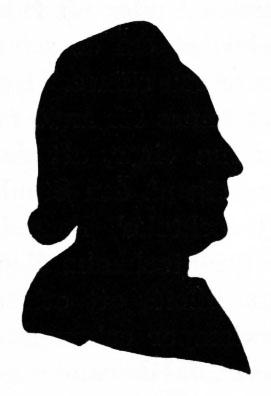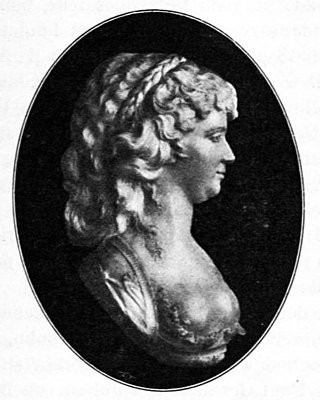Related Research Articles

Hat-making or millinery is the design, manufacture and sale of hats and other headwear. A person engaged in this trade is called a milliner or hatter.

Anna Maria Lenngren, née Malmstedt was one of the most famous poets in Swedish history. Her father and brother were also poets.

Fredrica Löf, also known as Fredrique Löwen, was a Swedish stage actress. She was the first female star at the newly founded national stage Royal Dramatic Theater, which was founded the year of her debut.

Caroline Frederikke Müller née Halle also known as Caroline Walther, was a Danish and later naturalized Swedish opera singer (mezzo-soprano). She was also active as an instructor at the Royal Dramatic Training Academy. She was a member of the Royal Swedish Academy of Music and a Hovsångare.

Marie Louise Marcadet née Baptiste was a Swedish opera singer and a dramatic stage actress of French origin. She was active in the Royal Swedish Opera as a singer, and in the Royal Dramatic Theatre and the French Theater of Gustav III as an actress. She was a member of the Royal Swedish Academy of Music from 1795.

Petter Stenborg was a Swedish stage actor and theater director. He was the director of the Stenborg Company or Svenska Comoedi-truppen from 1758 onward and as such the director of the Humlegårdsteatern (1773–80) in Stockholm. Petter Stenborg played an important role in Swedish theater history: he was a member of the pioneer actors of the first Swedish national stage in Bollhuset, and as the leader of the Stenborg theatre company, one of only two professional Swedish language theater companies active in the mid 18th-century, he kept professional Swedish language theater alive from the closure of the public theater in Bollhuset in 1754, until the inauguration of the Royal Swedish Opera (1773) and Royal Dramatic Theatre (1788).

Fredmans epistlar is a collection of 82 poems set to music by Carl Michael Bellman, a major figure in Swedish 18th century song. Though first published in 1790, it was created over a period of twenty years from 1768 onwards. A companion volume, Fredmans sånger was published the following year.

Sofia Franziska Stading was a Swedish opera singer of German origin. She is referred to as one of the more notable opera singers in Sweden during the Gustavian era. She was a Hovsångare and member of the Royal Swedish Academy of Music from 1788.

Ulrika "Ulla" Eleonora von Höpken, later von Wright, née von Fersen, was a Swedish countess and courtier. She is also famous in history as one of "the three graces" of the Gustavian age; three ladies-in-waiting immortalized in the poem Gracernas döpelse by Johan Henric Kellgren. She was a leading socialite and trendsetter in contemporary Sweden, and one of the best known personalities of the Gustavian age.

Lovisa "Louise" Augusta Meijerfeldtnée Sparre af Sundby, was a Swedish noble and courtier. She is famous in history as one of "the three graces" of the Gustavian age; three ladies-in-waiting immortalized in the poem Gracernas döpelse by Johan Henric Kellgren, and known profiles of the epoch.

Georg Haupt was a Swedish cabinet maker. Haupt was the son of a Nuremberg carpenter and learnt his trade as an apprentice of Johan Conrad Eckstein in Stockholm, after which he travelled as a journeyman to Amsterdam, Paris and London. He became cabinetmaker to King Adolphus Frederick in 1769 and a master carpenter and burgess in Stockholm in 1770 and 1771, respectively.
Lovisa von Plat, also known under the names Platskan and Moster von Platen was a Swedish brothel owner and procurer, active in Stockholm for about forty years until her death. She belonged to the elite of her trade and became a known figure of her time, mentioned in memoirs, diaries and literature.

Events from the year 1775 in Sweden
Antoinette Wilhelmina Nording (1814-1887), was a Swedish entrepreneur. She founded the famous perfume company Antoinette W Nording, for a time the biggest perfume company in Sweden, in 1847. She can be regarded as the first female perfumer in Sweden, and as a female pioneer.
1720 års skråordning was a law reform introduced in Sweden in 1720. It replaced the 1669 års allmänna skråordning and, with additional modifications, regulated the guild system and business life in Sweden until the Fabriks och Handtwerksordning and Handelsordningen of 1846.
Anna Maria Thalén (1781-1851) was a Swedish fashion trader. She belonged to the leading in her profession in early 19th-century Stockholm and are mentioned in contemporary memoirs and diary literature.
Margareta Dockvil, was a Swedish hatmaker. She played an important role in the guild conflict between the hat makers and hat ornament makers of Stockholm, and was the cause of an important reform.
Mary Faber, also called Mary Faber de Sanger,, was an African slave-trader. From the 1830s until 1852, she was a dominant figure of the Atlantic slave trade from Guinea, and known for her conflict with the British Royal Navy Anti-Slave Squadron.
Maria Augustin (1749-1803) was a Finnish businessperson. She is known for the many legal cases based on her right to conduct business as an unmarried woman.

Månglare was a historical profession in Sweden. A female månglare was often called månglerska. A månglare was essentially a street vendor with permission from the city authorities to engage in trade without being a member of the Guild, which was otherwise a necessity for anyone wishing to engage in business in the city. The profession was dissolved along with the Guilds by the Decree of Extended Freedom of Trade (Sweden) of 1864.
References
- Anteckningar om svenska qvinnor
- Ur den gamla Stockholmsposten: en samling artiklar [från årgångarna 1778-1784
- Samlade skrifter: Av Johan Henrik Kellgren. Utg. av Sverker Ek, Allan Sjöding, Otto Sylwan, Volym 7, Utgåva 1–5
- 1786: Vitterhetsakademiens jubileumssymposium 1986
- SSA, 0138, Magistraten och rådhusrättens arkiv, serie C5a, volym 04, sida 088.
- Anita Du Rietz (2013) Kvinnors entreprenörskap under 400 år, Stockholm, Dialogos Förlag.
- Gösta Selling (1946) Stockholms stads brandförsäkringskontors hus i kvarteret Aglaurus vid Mynttorget. Stockholm, Nordisk Rotogravyr.
- Martin Wottle (2005) ”Ett anspråkslöst förslag” i Kekke Stadin (red.) I all anspråkslöshet. En vänbok till Lars Björlin, Södertörns Studies in History 2, Stockholm ISBN 91-89315-51-0 s. 156 ff.